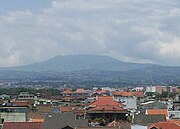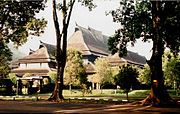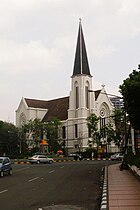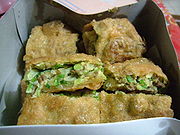Bandung (pronounced [bʌndʊŋ]) Indonesian: Kota Bandung) is the capital of West Java province in Indonesia, and the country's fourth largest city, and 2nd largest metropolitan area, with 7.4 million in 2007. Located 768 m (2,520 ft) above sea level, Bandung has relatively year-around cooler temperature than most other Indonesian cities. The city lies on a river basin and surrounded by volcanic mountains. This topography provides the city with a good natural defense system, which was the primary reason of Dutch East Indies government's plan to move the colony capital from Batavia to Bandung.
It has an area of 167.27 km² and 2,290,464 people in 2005, with a density of 13,693 people/km².[1] For the Hasil Survei Sosial Ekonomi Daerah 2007, 2,364,312 was the population, making it the fourth most populous city in Indonesia, after Jakarta, Surabaya and Medan.
The Dutch colonials first opened tea plantations around the mountains in the eighteenth century, followed by a road construction connecting the plantation area to the capital (180 km or 112 miles to the northwest). The European inhabitants of the city demanded the establishment of a municipality (gemeente), which was granted in 1906 and Bandung gradually developed itself into a resort city for the plantation owners. Luxurious hotels, restaurants, cafes and European boutiques were opened of which the city was dubbed as Parijs van Java (Dutch: "The Paris of Java").
| Parijs Van Java | |
| Motto: Bermartabat ('dignified') | |
| |
After Indonesian independence on 1945 onwards, the city experienced a rapid development and urbanization that has transformed Bandung from idyllic town into a dense 15,000 people/km² metropolitan area, a living space for over 2 million people. Natural resources have been exploited excessively, particularly in the conversions of protected upland area into highland villa and real estates. Although the city has encountered many problems (ranging from waste disposal, floods to chaotic traffic system, etc), Bandung however still has its charm to attract people flocking into the city, either as weekend travellers or living in.
Geography
Bandung, the capital of West Java province, located about 180 km (112 miles) southeast of Jakarta, is the fourth largest city in Indonesia. With over 2.9 million population in 2007 and over 7.2 million people on the greater Bandung regency and metropolitan area, it's one of the most densely populated city in Asia. It's rated the fastest-growing major city or urban region in Indonesia.[2] Its elevation is 768 metres (2,520 ft) above sea level and is surrounded by up to 2,400 m (7,874 ft) high Late Tertiary and Quarternary volcanic terrain.[3] The 400 km² flat of central Bandung plain is situated in the middle of 2,340.88 km² wide of the Bandung Basin; the basin comprises Bandung, the Cimahi city, part of Bandung Regency, part of West Bandung Regency, and part of Sumedang Regency.[4] The basin's main river is the Citarum; one of its branches, the Cikapundung, divides Bandung from north to south before it merges with Citarum again in Dayeuhkolot. The Bandung Basin is an important source of water for drinking water, irrigation and fisheries, and its 6,147 million m³ of groundwater is a major reservoir for the city.[4]
The northern part of the city is hillier than the rest; the distinguished truncated flat-peak shape of the Tangkuban Perahu volcano (Tangkuban Perahu literally means 'up-turned boat') can be seen from the city to the north. Long-term volcanic activity has created fertile andisol soil in the north, suitable for intensive rice, fruit, tea, tobacco and coffee plantations. In the south and east, alluvial soils deposited by the Cikapundung river are mostly found.
Geological data shows that the Bandung Basin is located on an ancient volcano, known as Mount Sunda, erected up to 3,000–4,000 metres (9,850–13,100 ft) during the Pleistocene age.[5] Two large scale eruptions took place; the first formed the basin and the other (est. 55,000 Before Present) blocked the Citarum river, turning the basin into a lake known as "the Great Lake of Bandung".[6] The lake drained away; the reason for which is the subject of ongoing debate among geologists.[7][8]
Due to its elevation, the climate in Bandung is cooler than most Indonesian cities and can be classified as humid; the average temperature is 23.6 °C (74.5 °F) throughout the year.[9] The average annual rainfall ranges from 1,000 millimetres in the central and southeast regions to 3,500 millimetres in the north of the city.[4] The wet season conforms with other Indonesian regions, around November to April.
History

The earliest reference to the city dates back to 1488, but archaeological findings suggest a type of Homo erectus species had lived on the banks of the Cikapundung River and around the old lake of Bandung.[11] During the seventeenth and eighteenth centuries, the Dutch East Indies Company (VOC) opened plantations in the Bandung area. A supply road connecting Batavia (now Jakarta), Bogor, Cianjur, Bandung, Sumedang and Cirebon was built in 1786. In 1809, Napoleon I, the Emperor of the French and conqueror of much of Europe including the Netherlands and its colonies,(before his ultimate downfall at Waterloo in 1815) ordered the Dutch Indies Governor H.W. Daendels to increase the defensive systems of Java against the British from India. Daendels built a road, stretching approximately 1,000 km (621 miles) from the west to the east coast of Java, and passing through Bandung.[12][13] In 1810, the road was laid down in Bandung and was named De Groote Postweg (or the 'main post road'), the present-day site of Asia-Afrika Street. Under Daendels' orders, R.A. Wiranatakusumah II, the chief administration of the Bandung regency at that time, moved its office from Krapyak, in the south, to a place near a pair of holy city wells (sumur Bandung), the present-day site of the city square (alun-alun). He built his dalem (palace), masjid agung (the grand mosque) and pendopo (public-official meeting place) in the classical orientation.[14] The pendopo faces Tangkuban Perahu mountain, which was believed to have a mystical ambience.
In 1880, the first major railroad between Batavia and Bandung was built,[15] boosting light industry in Bandung. Chinese workers from outside the city flocked in, to help run facilities, services and selling vendor machines. The old Chinatown district in Bandung is still recognisable in the railroad station vicinity. In 1906, Bandung was given the status of gemeente (municipality) and then later as stadsgemeente (city municipality) in 1926.
In the beginning of the 1920s, the Dutch East Indies government made plans to move the capital of Dutch East Indies from Batavia to Bandung. Accordingly, during this decade, the Dutch colonial government started building military barracks, the central government building (Gouvernments Bedrijven, the present-day Gedung Sate) and other government buildings. This plan, however, was cut short by World War II after which the Dutch were not able to re-established their colony.
The fertile area of the Parahyangan Mountains surrounding Bandung supports productive tea plantations. In the nineteenth century, Franz Junghuhn introduced the cinchona (kina) plant.[16] With its cooler elevated landscape, surrounded by major plantations, Bandung became an exclusive European resort area.[17] Rich plantation owners visited the city on weekends, attracting girls and businessmen from the capital, Batavia. Braga Street grew into a promenade street with cafes, restaurants and boutique shops. Two art-deco style hotels, Savoy Homann and Preanger, were built in the vicinity of the Concordia Society, a club house for the wealthy with a large ballroom and a theatre.[15] The nickname "Parijs van Java" was given to the city.
After the Indonesian Independence in 1945, Bandung was determined as the capital of West Java province. During the 1945–1949 independence struggle against the Dutch when they wanted to reclaim their colonies, Bandung was one of the heaviest battle places. The Dutch military commander set an ultimatum for the Indonesian combatants in Bandung to leave the city. In response, on 24 March 1946, much of the southern part of Bandung was deliberately set alight as the combatants left; an event known as the Bandung Lautan Api or 'Bandung Sea of Flame'.[18]
In 1955, the first Asian-African Conference -- also known as the Bandung Conference -- was held in Bandung, attended by head of states representing twenty-nine countries and colonies from Asia and Africa. The conference venue was at the Gedung Merdeka, the former Concordia Society building. The conference announced 10 points of declaration on world peace promotion and oppositions against colonialism, known as the Declaration of Bandung, which followed by wave of nationalism movements around the globe and remapped the world politics.[19] The conference was also the first international conference of people of color in the history of mankind.[20] Richard Wright in his book, The Color Curtain, captured the epic meanings of the conference for people of color around the world.[20]
In 1987, the city boundary was expanded with the Greater Bandung (Bandung Raya) plan; a relocation of higher concentration development outside the city in an attempt to dilute some of population in the old city. During its development, however, the city core is often uprooted, old faces are torn down, lot sizes regrouped, and what was idyllic residence is bustling chain supermarkets and rich banks.[17]
Administration
The city area in 1906 was only 19.22 square kilometres and it has been expanded several times until the 1987 expansion into 167.2965 km².[9] The city administration is divided into 26 subdistricts (kecamatan) and 139 villages (kelurahan). A mayor (walikota) leads the city administration. Since 2008, the city residents directly voted for a mayor, while previously mayors were nominated and selected by the city council members or known as the Regional People's Representative Council (DPRD). As of 2003, the total number of city administration personnel, including the mayor, is 20,163.[9]Architecture
Bandung is renowned for its large stock of Dutch colonial architecture; most notably the tropical Art Deco architectural style. Henri Maclaine-Pont is among the first Dutch architects who realized how important to combine each architectural style with culture of local people. He stressed that modern architecture should be evolved from local history and native elements.[22] In 1920, Pont planned and designed buildings for the first technical university in the Dutch East Indies, Technische Hogeschool te Bandung (the present-day Institut Teknologi Bandung), after which he was named as a professor in architecture at the university. A striking local Javanese roof style is noticeably seen on top of the campus' ceremonial hall, embedded in his artwork.[22]
In the same year, another Dutch architect, J Gerber, designed Gouverments Bedrijven (Government Companies) in line with the colonial government plan to move the capital from Batavia to Bandung. The building is an example of a harmonious mixture between West and East architectural styles, particularly the Italian Renaissance style of arch structures in the west wing and Thailand's pagoda-like structures in the middle section.[citation needed] The building is known as Gedung Sate, named after the distinguished small satay shaped structure on the roof, and used as the head office of West Java provincial government and West Java's house of representative.
The modern and native architectural blending was followed by several Dutch architects that have shaped the city landmarks. In the 1930s, Bandung was known also as the city of architecture laboratory because of many Dutch architects made some experiments with new architectural designs. Albert Aalbers added the expressionist architecture style to the Art Deco by designing the DENIS bank (1936) and renovated the Savoy Homann Hotel (1939). C.P.W. Schoemaker was one of celebrated architects who strongly added native elements in his artworks, including the Villa Isola (1932), Hotel Preanger (1929), the regional military headquarter (1918), Gedung Merdeka (1921) and ITB Rectorate Building (1925).[22]
Culture
Bandung is the capital of West Java, a province of which most of its residents are mainly Sundanese people. Sundanese language is spoken as the first language and is commonly used as informal language for communication in streets and markets, while Indonesian - Indonesia's national language and a lingua franca among its many ethnic units - is used as a second language and the language of government, businesses, and instruction at schools.
A popular traditional musical instrument is angklung, made of parallel bamboo tubes tuned to specific frequencies with a hammer and is shaken to produce certain notes. Music is performed by a choir of angklung players, each of whom are responsible for sounding certain notes. Its melody is only slightly different from that of Central Java's gamelan ensembles.
Tourism industry
Bandung has served for popular weekend-break destination for people living in Jakarta for many reasons. The cooler climate of highland plantation area, the varieties of food, the cheaper fashion shops located in factory outlets and distros, golf courses, and the friendliness of local people have become the main attraction of the city.[23]

In the 1990s, local designers opened denim clothing stores along Cihampelas Street which gave Bandung another nickname, the "Tourist Shopping City" (Kota Wisata Belanja). It was a success as the-then residential street had been fully transformed into a "jeans street". The city attracts people from other big cities to buy local fashion wears, as they are cheaper than branded items.[24]
The city gained more shoppers to come when textile factories in the outskirt of Bandung opened a fashion store that sells their products directly from the factory. The products are tagged as sisa export (rejected or over-produced export quality items) and these shops are called factory outlets. The trend was followed by another factory outlets.[25]
Sports
Bandung is the home town of the soccer team Persib Bandung. Another soccer team Persikab is based in neighbouring town of Soreang, the capital city of Bandung Regency (Kabupaten Bandung) and Pelita Jaya Jawa Barat (PJJB) who share it's home base stadium with Persikab at Si Jalak Harupat stadium in Soreang and Pro Duta. Persib Bandung's home base stadium is Siliwangi Stadium.
Other popular sports in Bandung include badminton (see Taufik Hidayat, gold medal winner at the 2004 Summer Olympics) and basketball, a well known basketball team which taking part in IBL league is Garuda Flexi (formerly PanAsia). The roads leading up to Lembang and Dago are popular routes for mountain cycling during the weekend. In the hillside around Bandung, there are a couple of golf courses.
Professional hockey player Richie Regehr was born in Bandung. Richie played professional hockey for the Calgary Flames and currently plays for Eisbären Berlin of the DEL. Regehr was born to Canadian parents working as missionaries in Bandung.













No comments:
Post a Comment